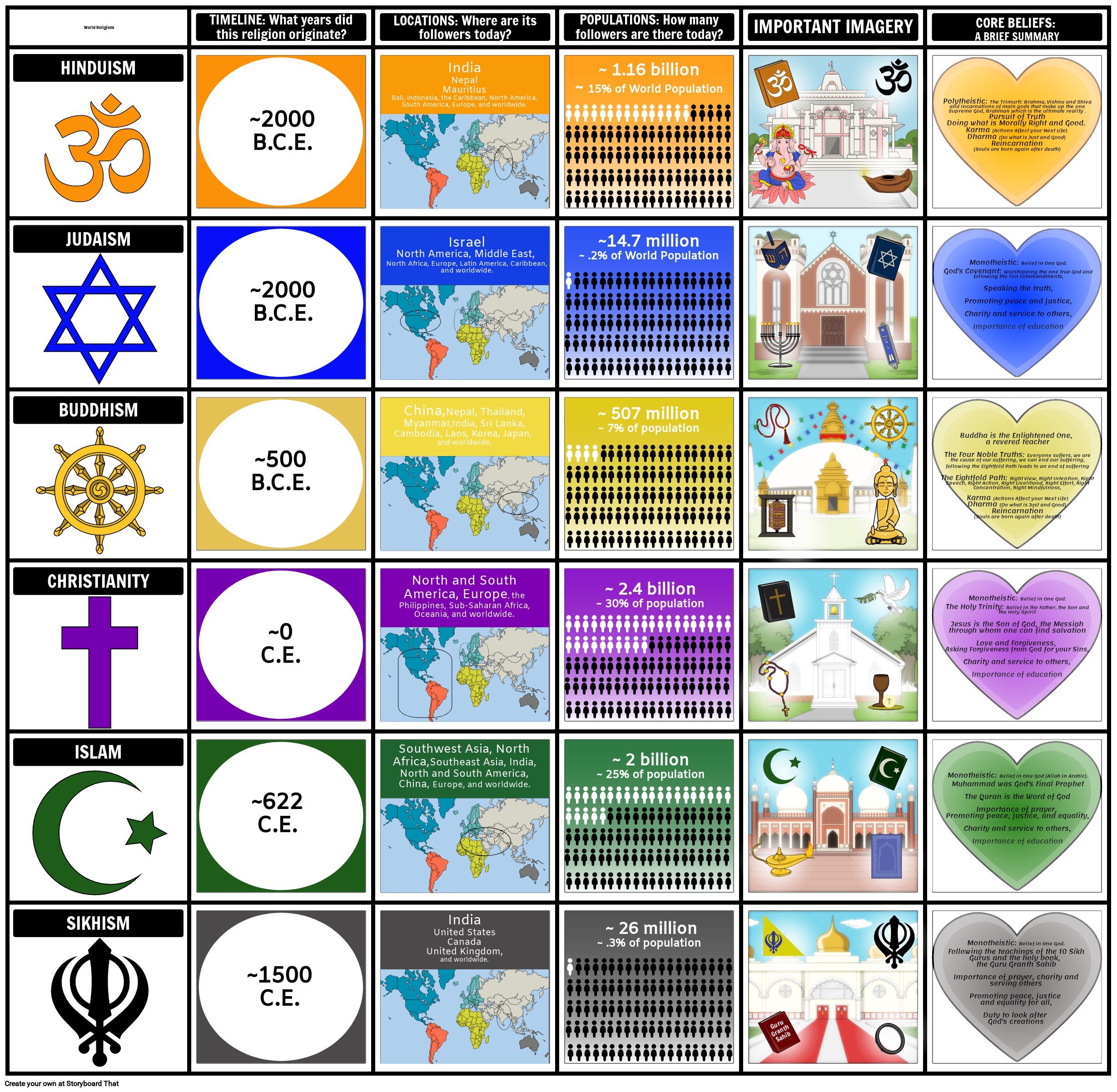Lesson Plan Overview
Creating a compare and contrast chart is a great way for students to display their knowledge about the major world religions such as Christianity, Islam, Hinduism, Buddhism, Judaism, and Sikhism. In this activity, students will fill in important information about each major world religion using text and illustrations that include symbols, characters, infographics, scenes, or objects.
Topics that are helpful for students to track include:
- When the religions originated
- Where their followers are located around the world
- How many followers each religion has today
- What is some important imagery
Students can use the chart as a way to take notes as they learn about each religion and then use the chart as a study guide. Alternatively, a teacher may have students create the chart as a final assessment.
Template and Class Instructions
(These instructions are completely customizable. After clicking "Copy Activity", update the instructions on the Edit Tab of the assignment.)
Due Date:
Objective: Create a storyboard chart of the major world religions such as: Christianity, Islam, Hinduism, Buddhism, Judaism, and Sikhism. Highlight important facts about each religion such as where its followers live in the world, how many followers it has today, when it originated and important symbols or objects.
Student Instructions:
- Click “Start Assignment”.
- Using the template, fill in facts using words and illustrations about each of the major world religions.
- For each cell, include accurate information and create an illustration that represents each using appropriate scenes, characters, infographics and items.
Lesson Plan Reference
Student Rubric
(You can also create your own on Quick Rubric.)
| Proficient | Emerging | Beginning | |
|---|---|---|---|
| Facts | Text and images include a clear explanation of important facts about each major world religion such as: the origin, location, population and important symbols or objects. | Text and images include an explanation of important facts about each major world religion, but the explanation may lack clarity or there may be some inaccuracies. | Text and images do not explain important facts about each major world religion. Information is mostly missing or inaccurate. |
| Storyboard Images and Effort | Student clearly shows effort to convey the facts about each world religion through appropriate scenes, characters, items, symbols or infographics. Illustrations clearly show that time, care and effort have been put in. | Student attempts to convey facts about each world religion through use of graphics, but the depiction may be confusing, disordered, or lack some detail. | Student does not clearly convey facts about the world religions and the depictions are inaccurate or inappropriate. |
| Spelling and Grammar | Student uses exemplary spelling and grammar. There are no errors. | Student makes one or two minor errors in spelling and grammar. | Student makes multiple errors in spelling and grammar. |
Lesson Plan Overview
Creating a compare and contrast chart is a great way for students to display their knowledge about the major world religions such as Christianity, Islam, Hinduism, Buddhism, Judaism, and Sikhism. In this activity, students will fill in important information about each major world religion using text and illustrations that include symbols, characters, infographics, scenes, or objects.
Topics that are helpful for students to track include:
- When the religions originated
- Where their followers are located around the world
- How many followers each religion has today
- What is some important imagery
Students can use the chart as a way to take notes as they learn about each religion and then use the chart as a study guide. Alternatively, a teacher may have students create the chart as a final assessment.
Template and Class Instructions
(These instructions are completely customizable. After clicking "Copy Activity", update the instructions on the Edit Tab of the assignment.)
Due Date:
Objective: Create a storyboard chart of the major world religions such as: Christianity, Islam, Hinduism, Buddhism, Judaism, and Sikhism. Highlight important facts about each religion such as where its followers live in the world, how many followers it has today, when it originated and important symbols or objects.
Student Instructions:
- Click “Start Assignment”.
- Using the template, fill in facts using words and illustrations about each of the major world religions.
- For each cell, include accurate information and create an illustration that represents each using appropriate scenes, characters, infographics and items.
Lesson Plan Reference
Student Rubric
(You can also create your own on Quick Rubric.)
| Proficient | Emerging | Beginning | |
|---|---|---|---|
| Facts | Text and images include a clear explanation of important facts about each major world religion such as: the origin, location, population and important symbols or objects. | Text and images include an explanation of important facts about each major world religion, but the explanation may lack clarity or there may be some inaccuracies. | Text and images do not explain important facts about each major world religion. Information is mostly missing or inaccurate. |
| Storyboard Images and Effort | Student clearly shows effort to convey the facts about each world religion through appropriate scenes, characters, items, symbols or infographics. Illustrations clearly show that time, care and effort have been put in. | Student attempts to convey facts about each world religion through use of graphics, but the depiction may be confusing, disordered, or lack some detail. | Student does not clearly convey facts about the world religions and the depictions are inaccurate or inappropriate. |
| Spelling and Grammar | Student uses exemplary spelling and grammar. There are no errors. | Student makes one or two minor errors in spelling and grammar. | Student makes multiple errors in spelling and grammar. |
How To Help Students Compare Different Religions
Introduce Different Religions
Begin by introducing the basics of different religions to students. For instance, the meanings and origins of Islam and Christianity. Teachers can also start the discussion by generally discussing the concept of religion with students and then slowly move to different types of religions. Some students might also be aware of many different religions so the lectures can be built on prior knowledge of students.
Analyze Common Grounds
Help students recognize and compare common themes, such as beliefs about God, the afterlife, morality, and the meaning of life, that appear in other faiths. Students can find similarities on the basis of monotheism or polytheism, the purpose of living beings, basic rules of life, etc.
Examine the Variations in Practice
Look at the many rites, ceremonies, and procedures that each religion employs, and talk about their importance in terms of worship and daily living. Students can also reflect on the different places of worship and highly regarded aspects of the religion. For instance, Churches in Christianity and Mosques in Islam are significant places of worship.
Encourage a Respectful Environment
Place a strong emphasis on the necessity of approaching the study of religion with an open mind, respect, and sensitivity to other belief systems and behaviors. Encourage the students to express their opinions and perspectives but also listen carefully to other students and respect their opinions.
Frequently Asked Questions About Comparing and Contrasting World Religions
What are the main doctrines of the world's major religions?
Christianity, Islam, Judaism, Hinduism, Buddhism, and Sikhism are some of the widely followed religions in the world. Every religion has unique cultural manifestations, traditions, and beliefs. These religions can be differentiated based on beliefs, rituals, practices, and history. Most of the key religions convey the purpose of human life, the meaning of peace, and how human beings can spend their lives on Earth.
How do various religions address the idea of heaven and hell?
Religions hold a vast range of beliefs on the afterlife. Others place more emphasis on ideas of paradise, and hell, while some (such as Hinduism and Buddhism) believe in reincarnation or different lives. Each religion has different beliefs based on the key principles provided by their religious leaders or Holy texts.
What are the key rites and customs attributed to various religions?
Prayer, meditation, worship sessions, pilgrimage, dietary restrictions, ceremonies, and festivals are just a few examples of practices and rituals, all of which vary widely amongst various religions. The majority of the religions in the world have an entire set of systems the people follow for instance, Muslims take Halal diets, Jews eat Kosher food, etc.
More Storyboard That Activities
Judaism
This Activity is Part of Many Teacher Guides
Testimonials

“By using the product, they were so excited and they learned so much...”–K-5 Librarian and Instructinal Technology Teacher

“I'm doing a Napoleon timeline and I'm having [students] determine whether or not Napoleon was a good guy or a bad guy or somewhere in between.”–History and Special Ed Teacher

“Students get to be creative with Storyboard That and there's so many visuals for them to pick from... It makes it really accessible for all students in the class.”–Third Grade Teacher
© 2025 - Clever Prototypes, LLC - All rights reserved.
StoryboardThat is a trademark of Clever Prototypes, LLC, and Registered in U.S. Patent and Trademark Office













